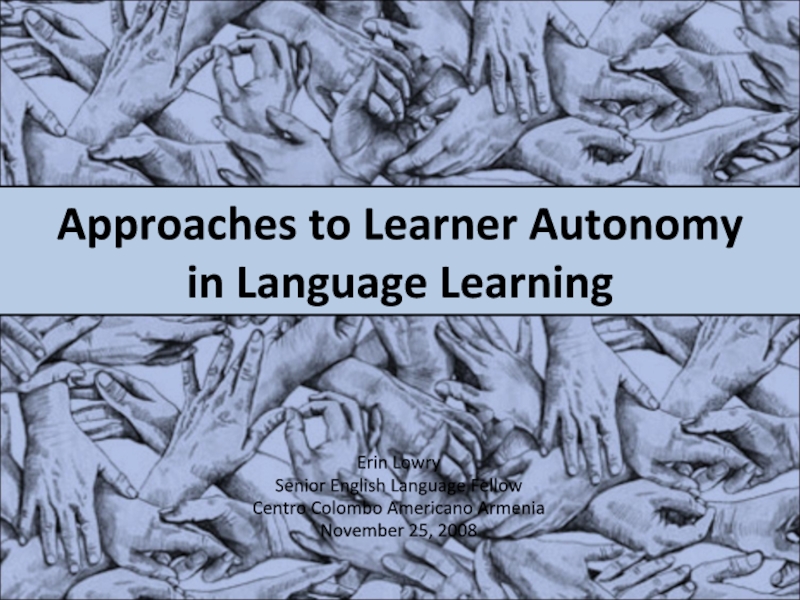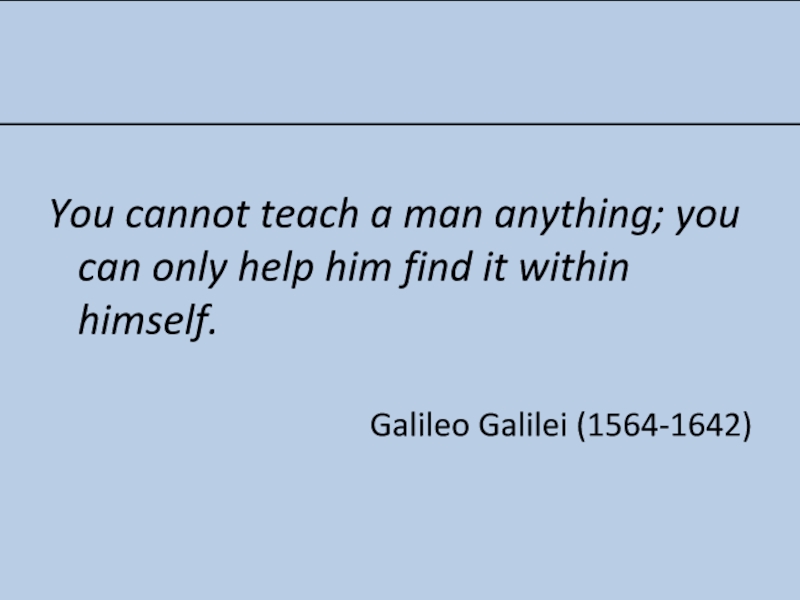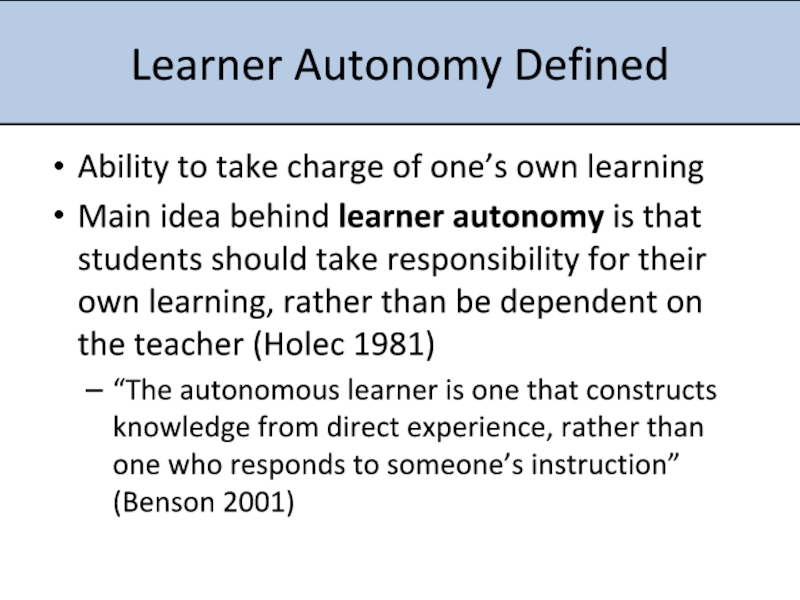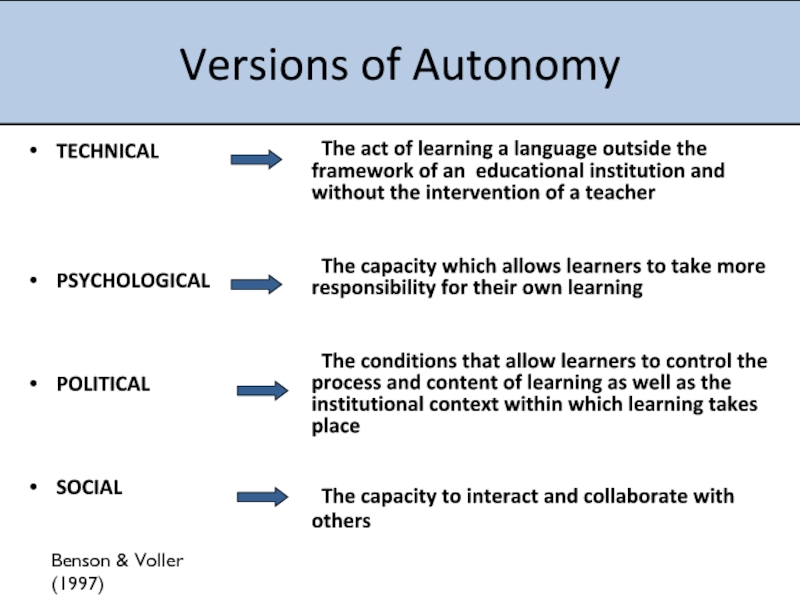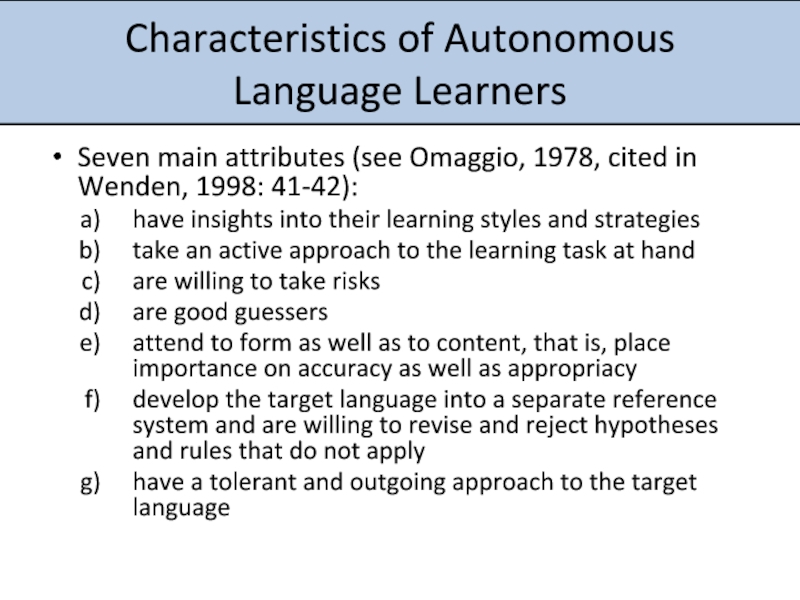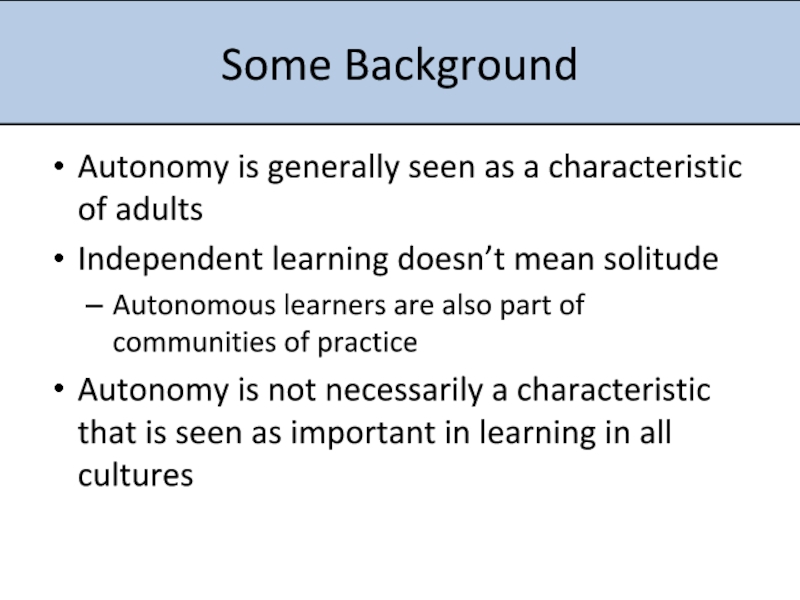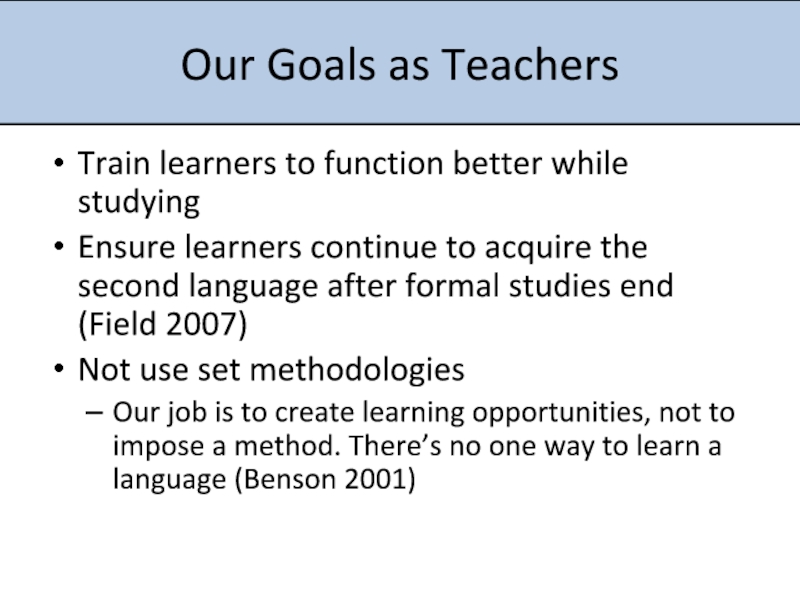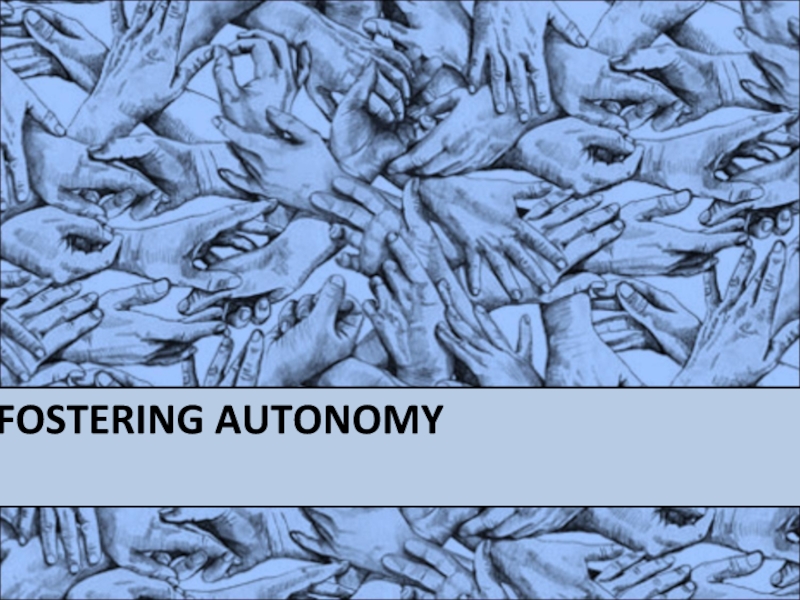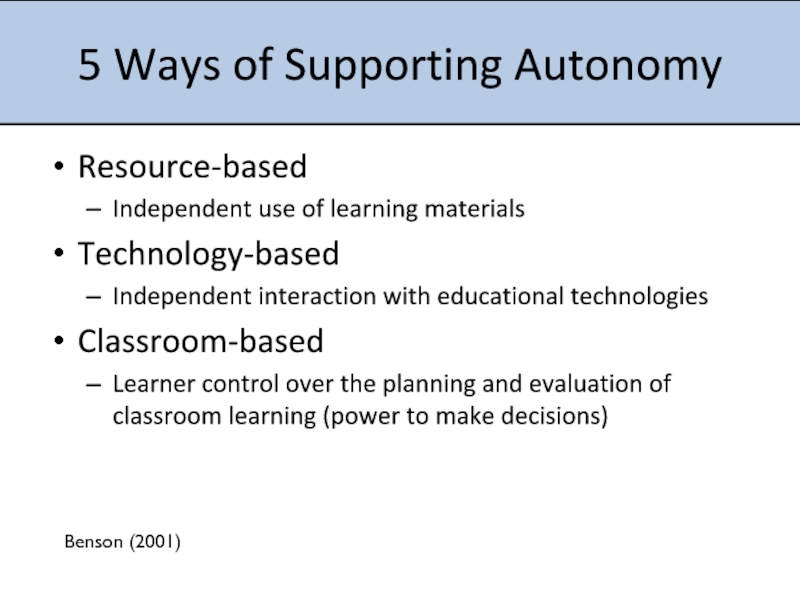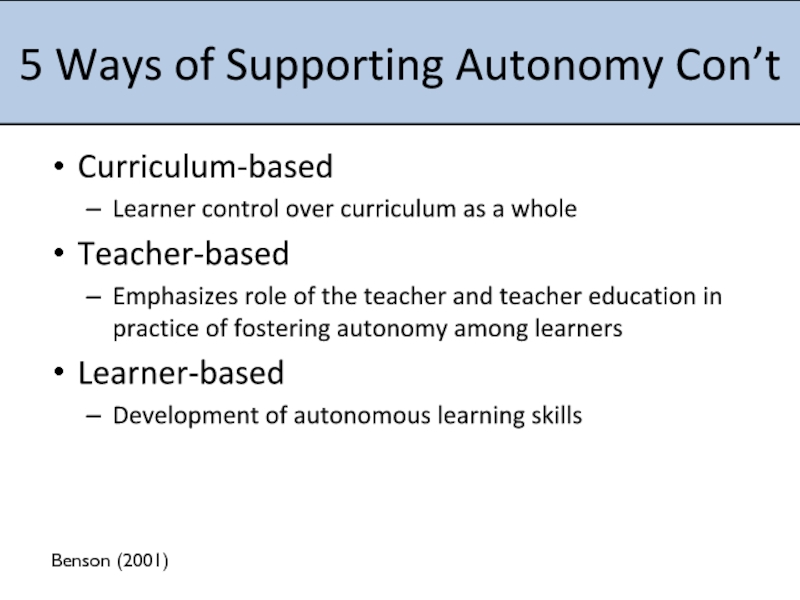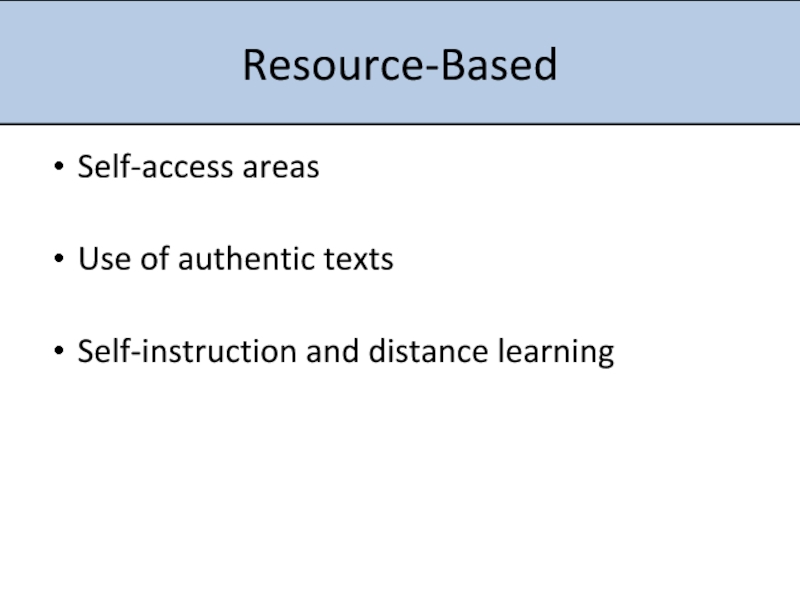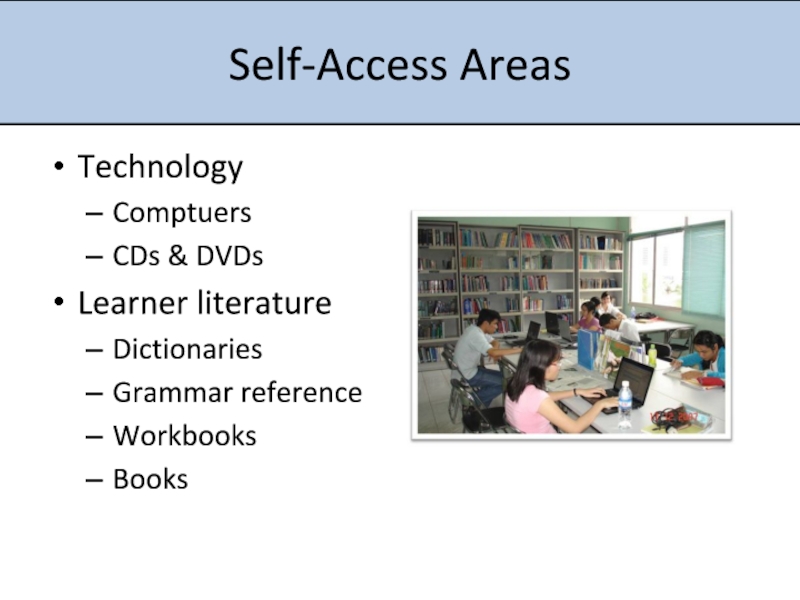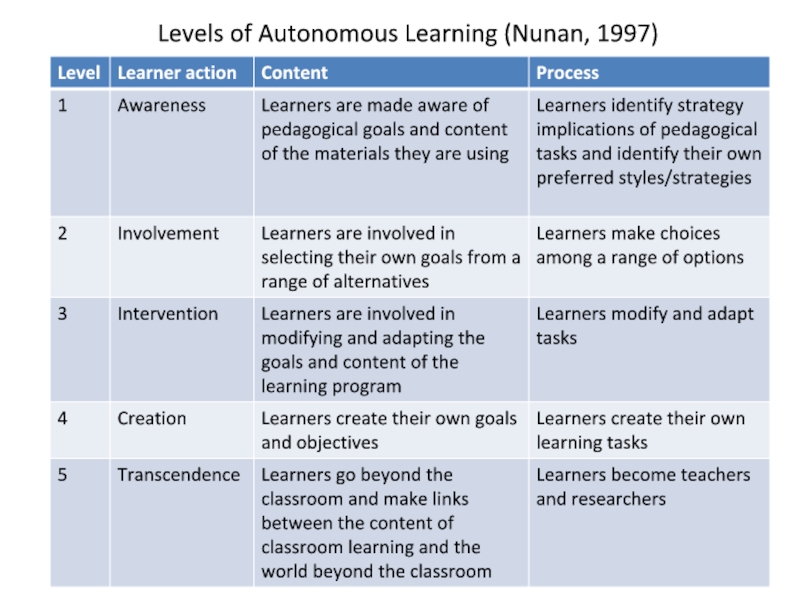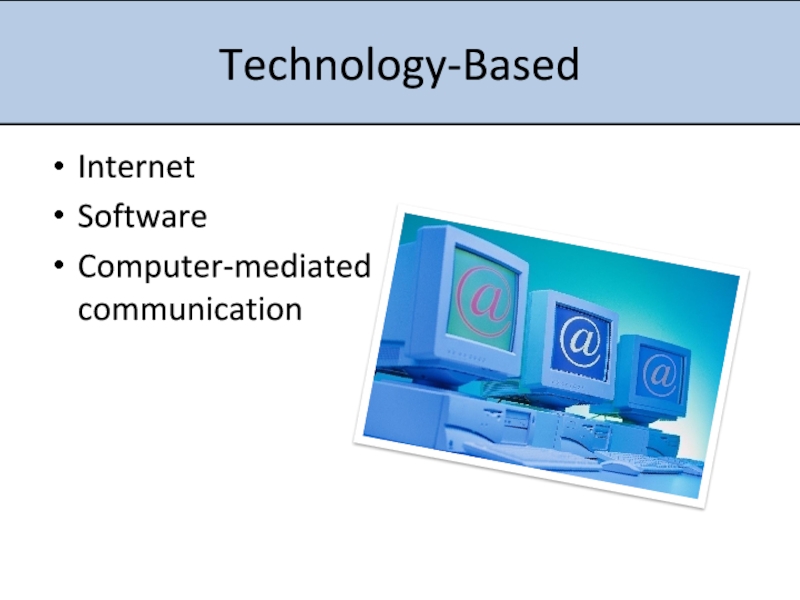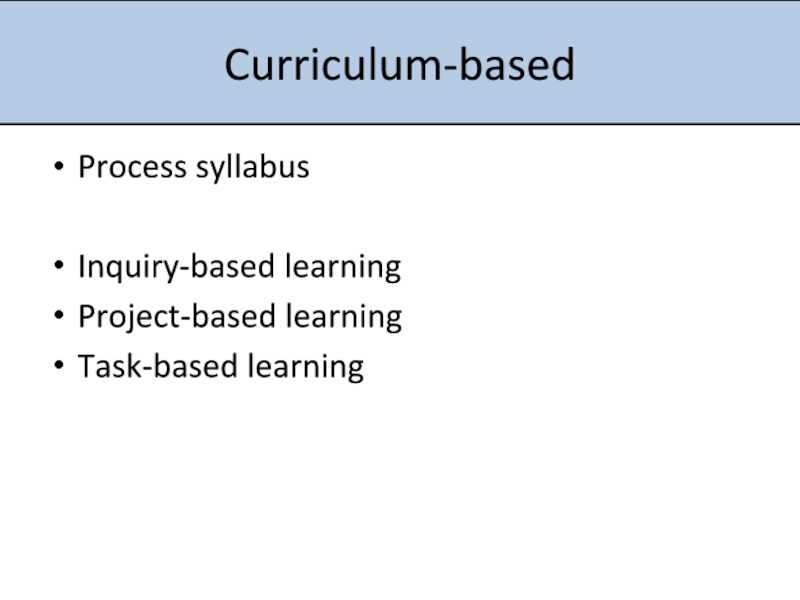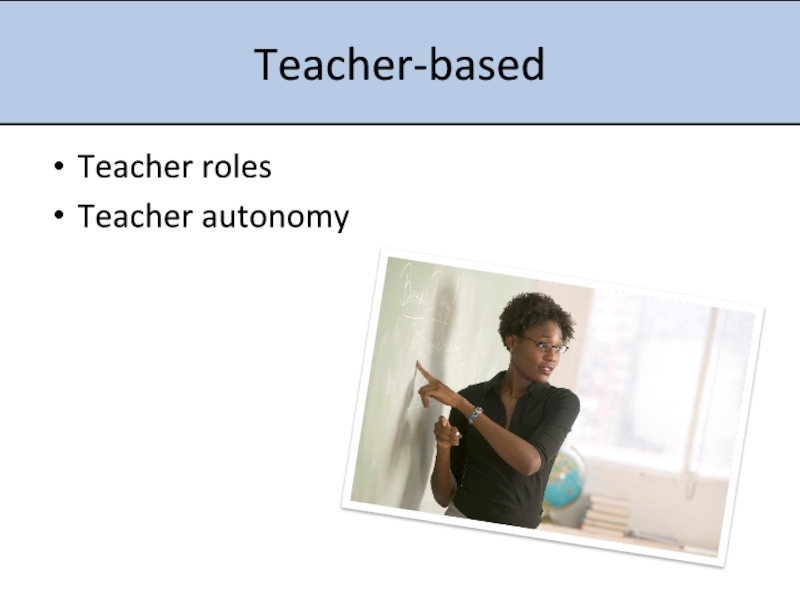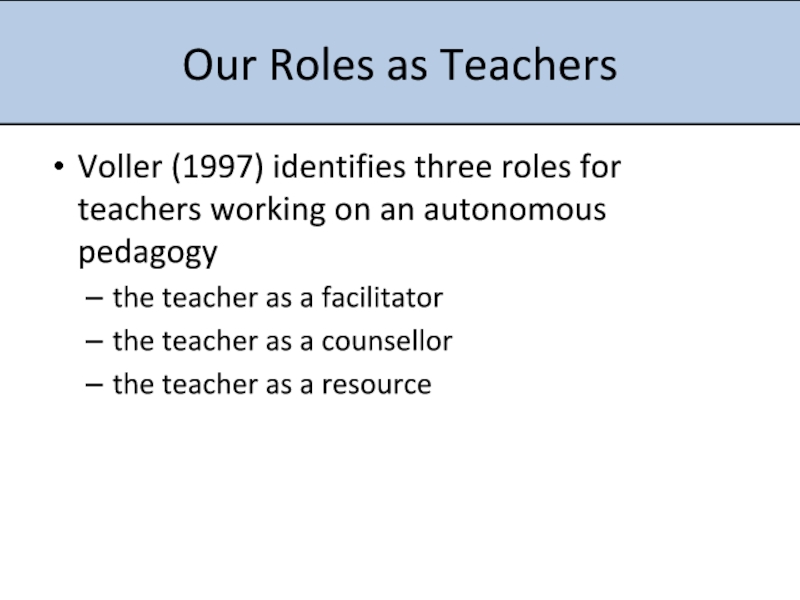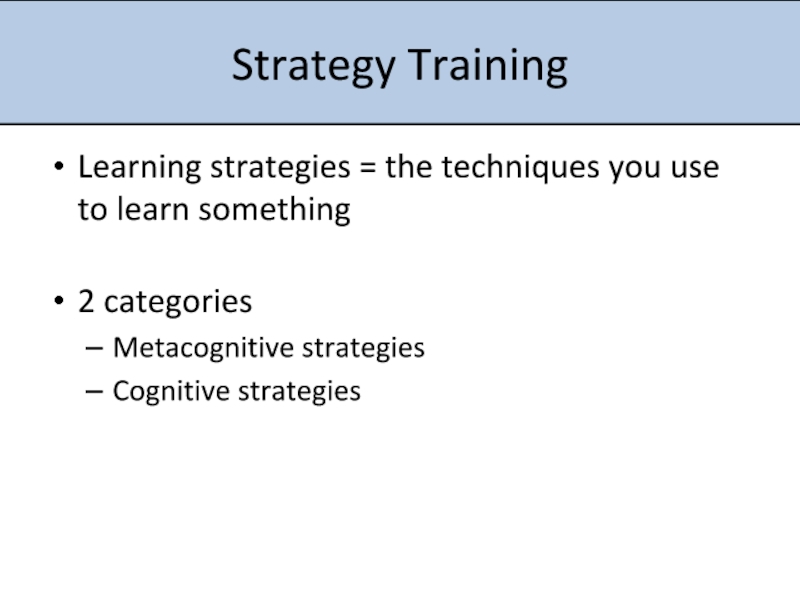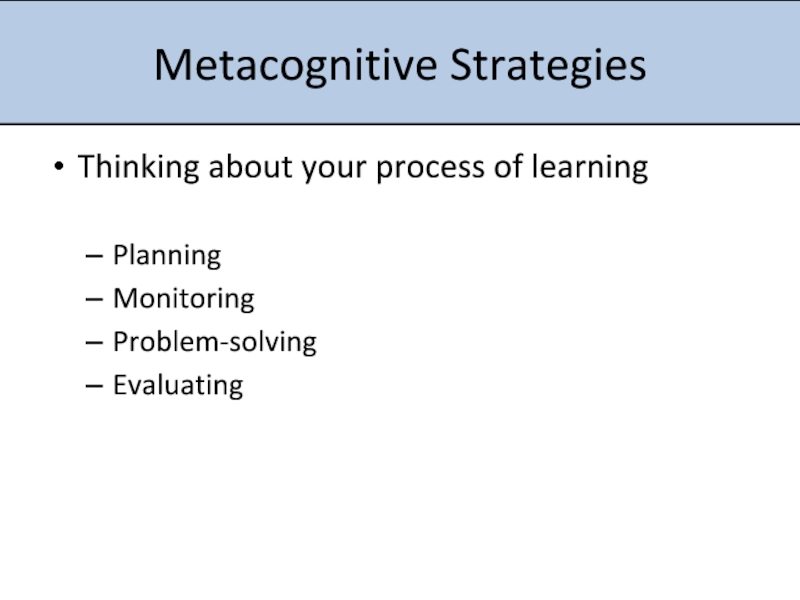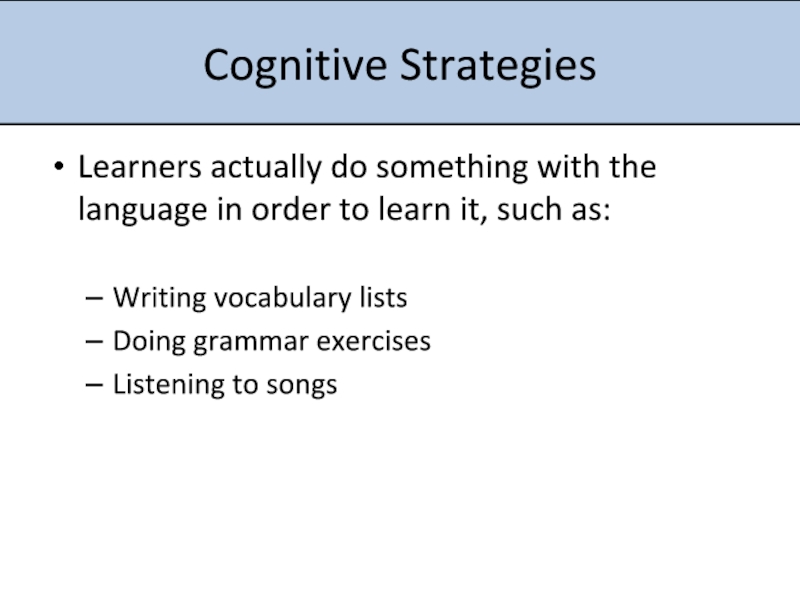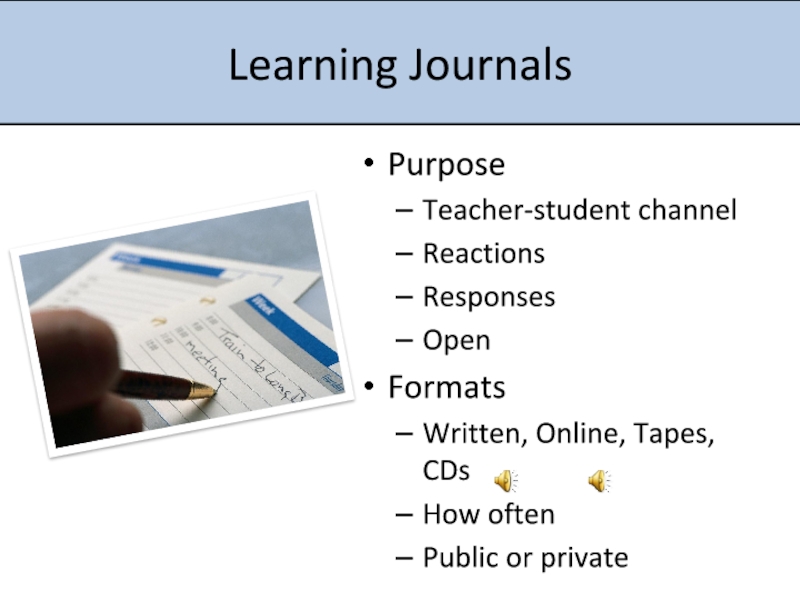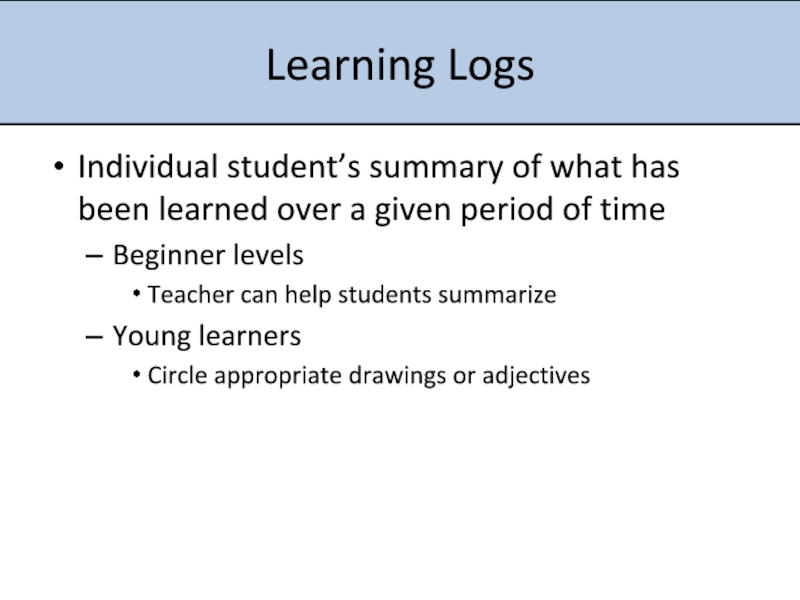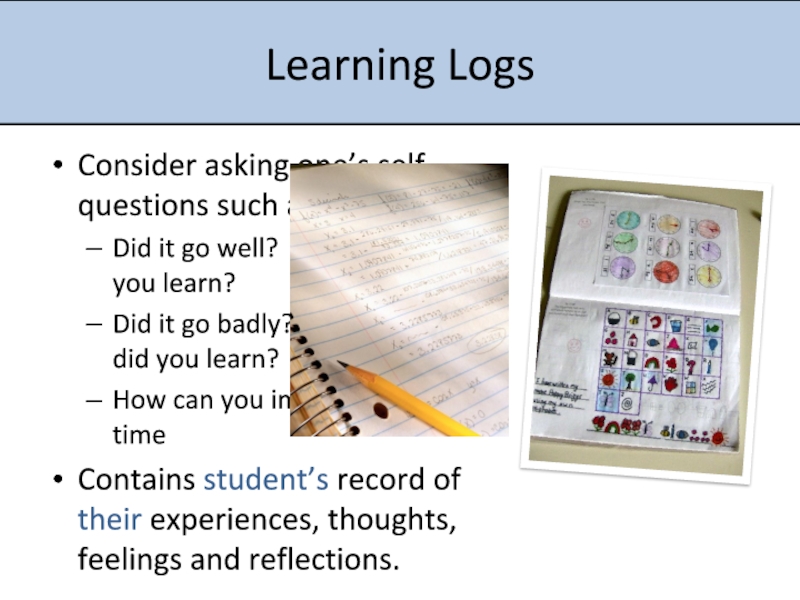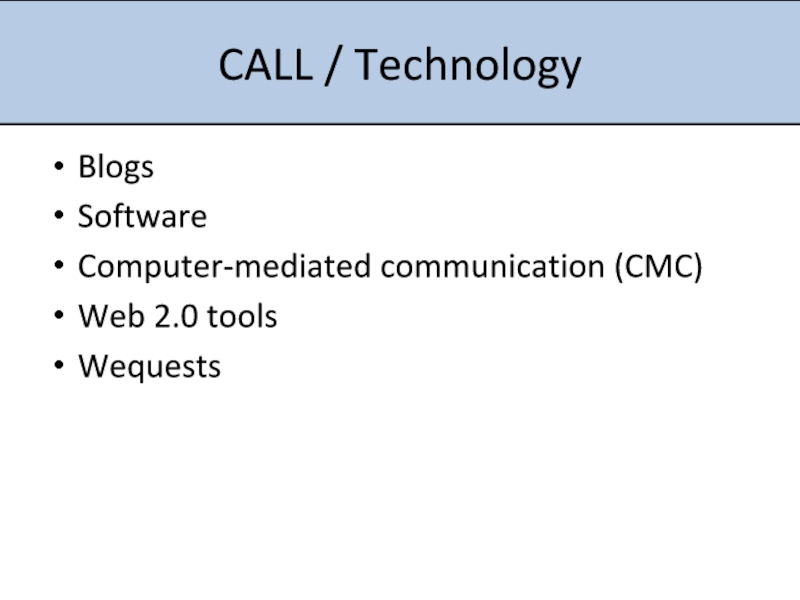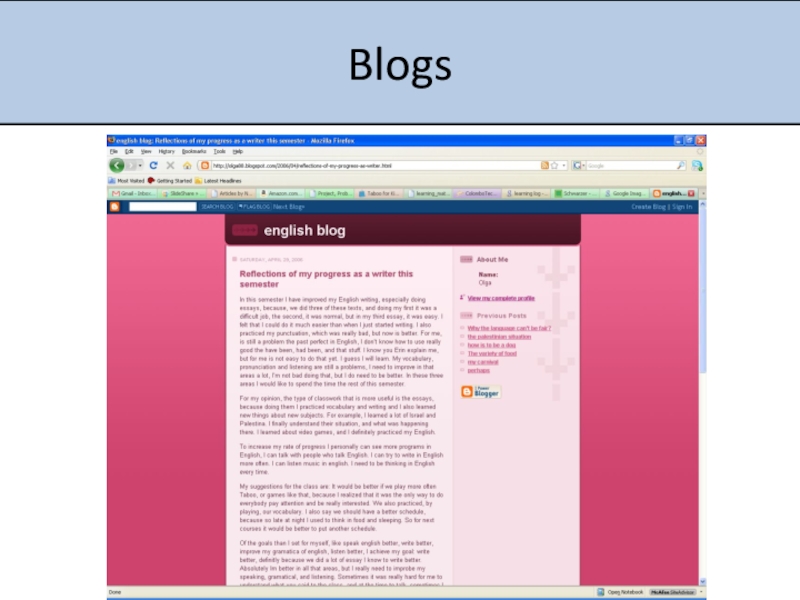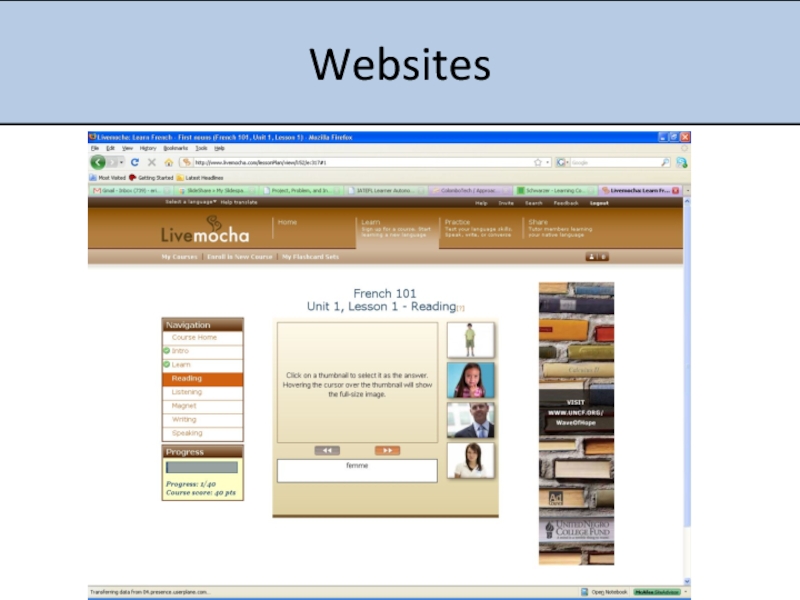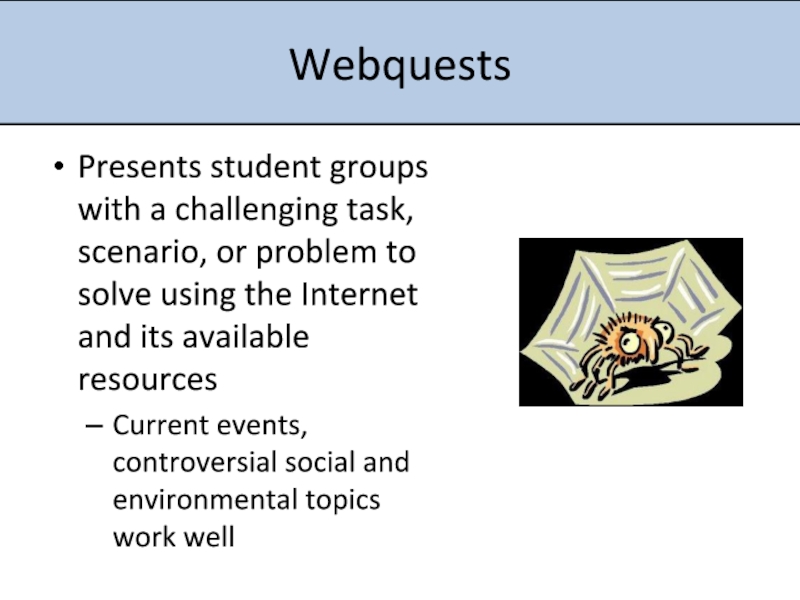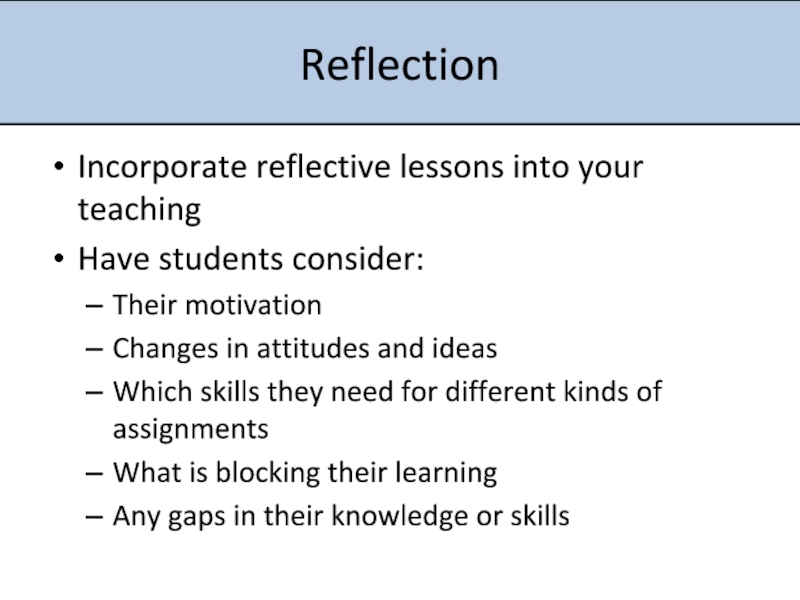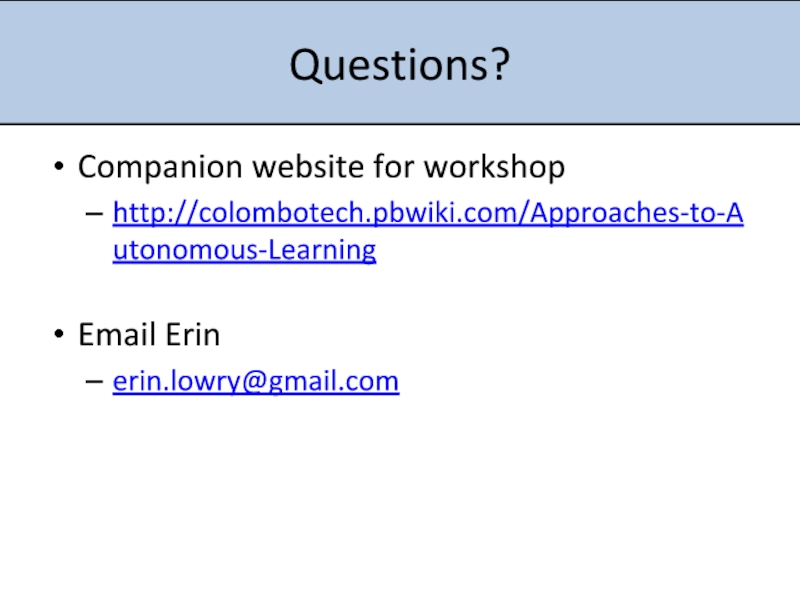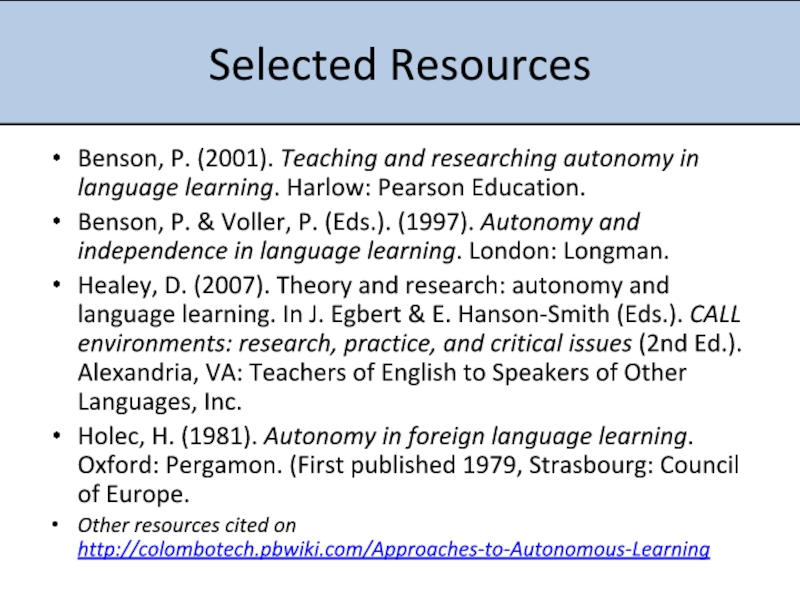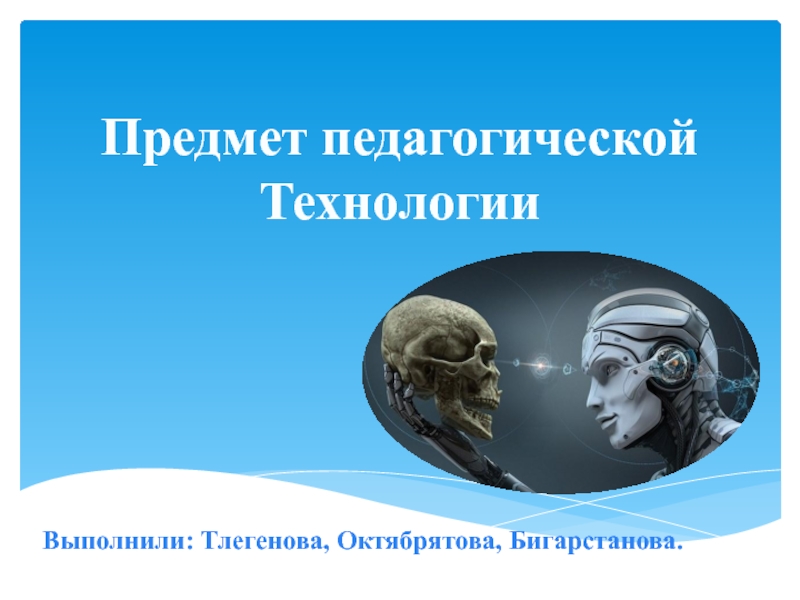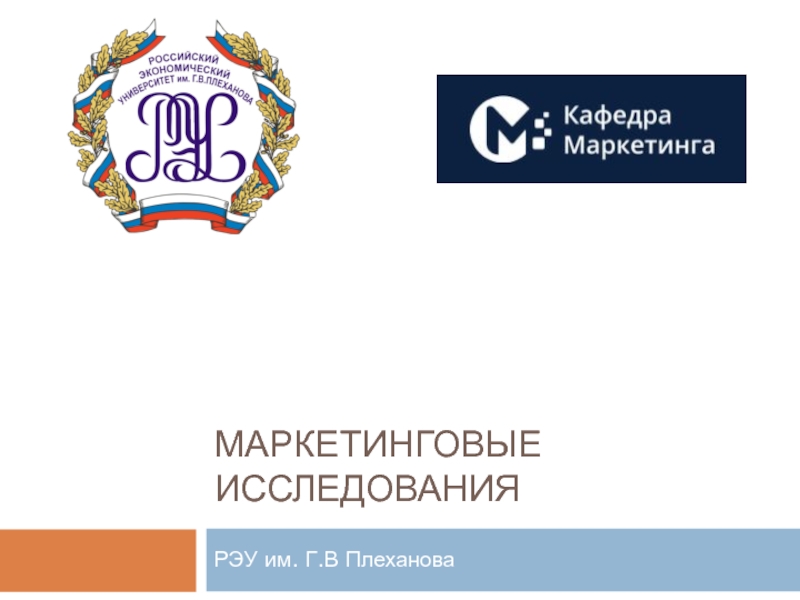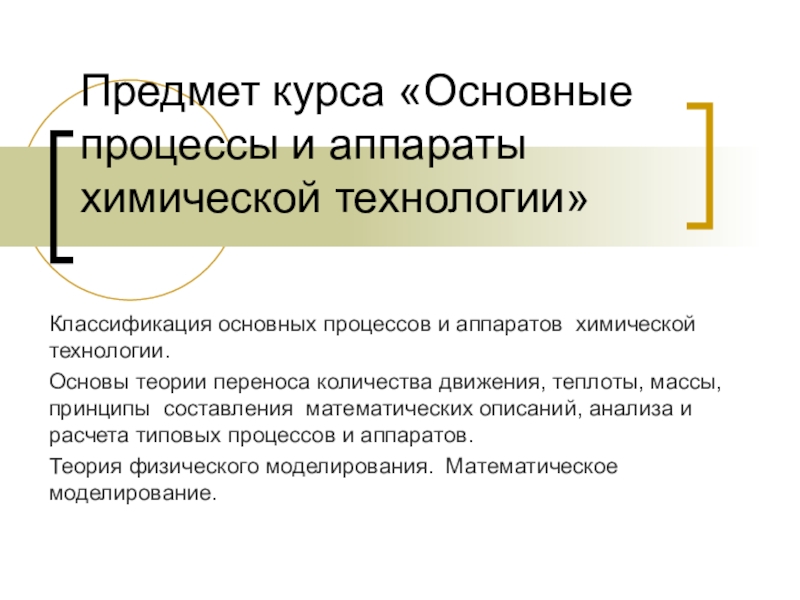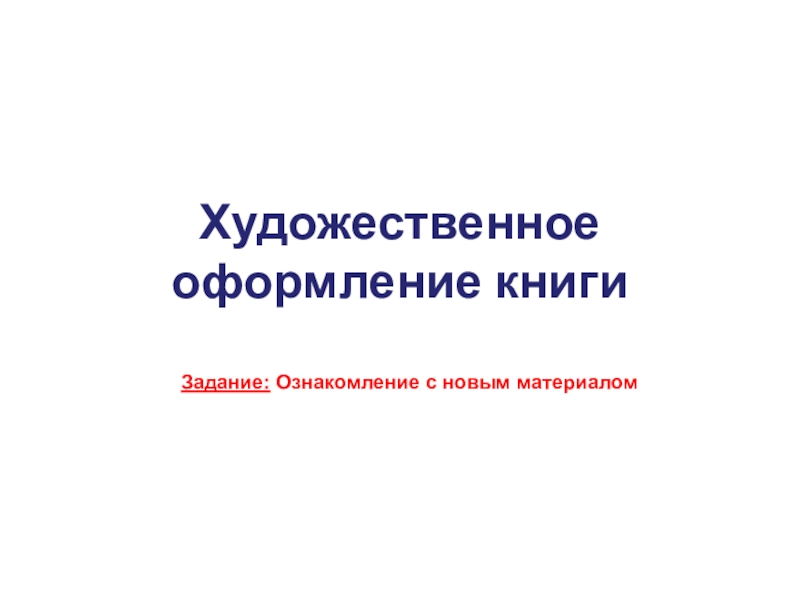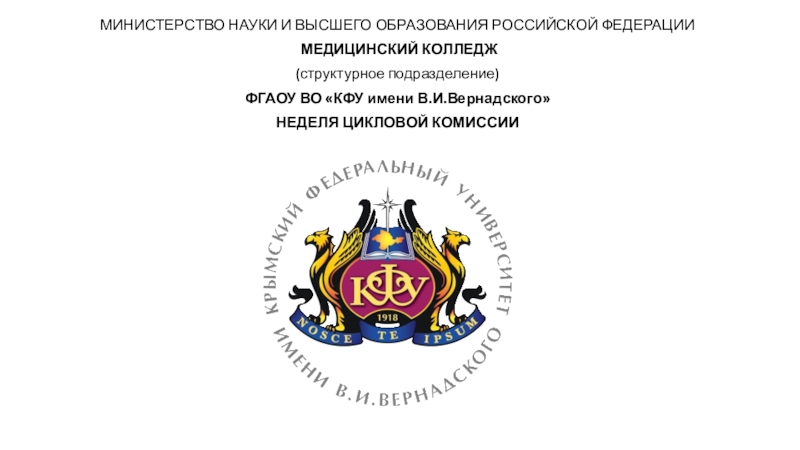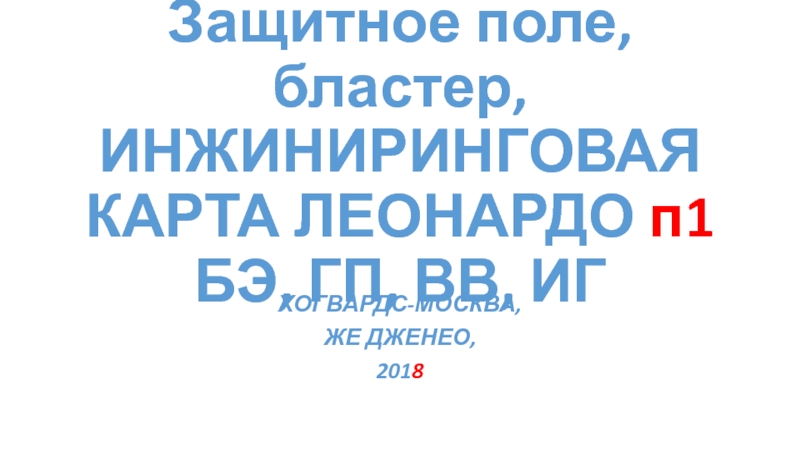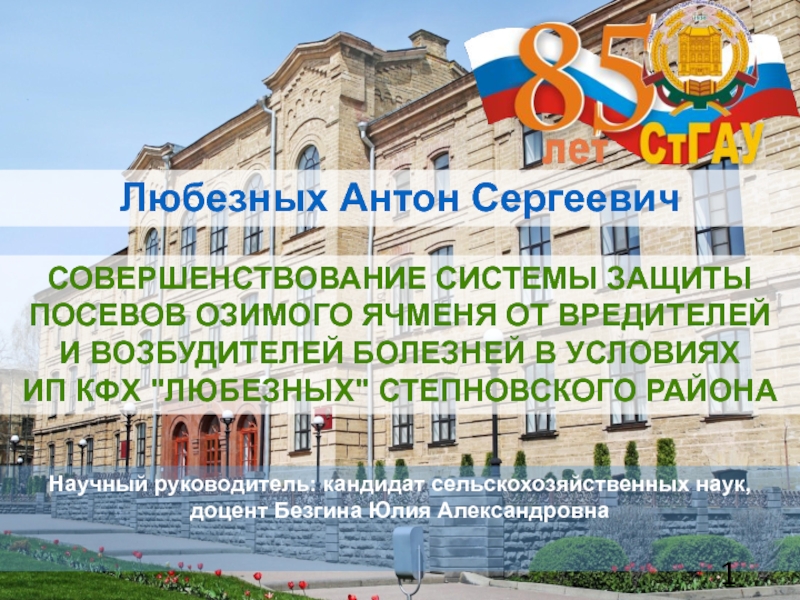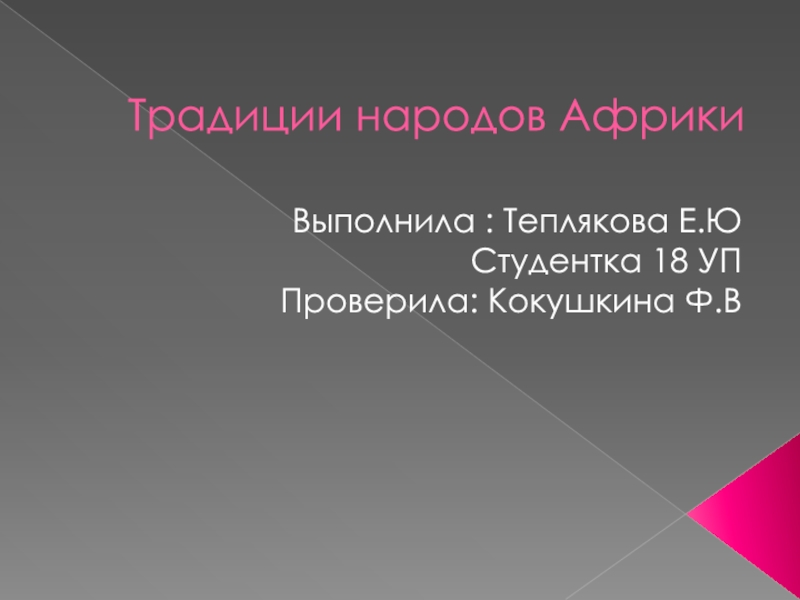Разделы презентаций
- Разное
- Английский язык
- Астрономия
- Алгебра
- Биология
- География
- Геометрия
- Детские презентации
- Информатика
- История
- Литература
- Математика
- Медицина
- Менеджмент
- Музыка
- МХК
- Немецкий язык
- ОБЖ
- Обществознание
- Окружающий мир
- Педагогика
- Русский язык
- Технология
- Физика
- Философия
- Химия
- Шаблоны, картинки для презентаций
- Экология
- Экономика
- Юриспруденция
Approaches to Learner Autonomy in Language Learning
Содержание
- 1. Approaches to Learner Autonomy in Language Learning
- 2. You cannot teach a man anything; you
- 3. Learner Autonomy DefinedAbility to take charge of
- 4. Characteristics of AutonomyConcept based in natural tendency
- 5. Versions of AutonomyTECHNICALPSYCHOLOGICALPOLITICALSOCIAL The act of learning a
- 6. Characteristics of Autonomous Language LearnersSeven main
- 7. What Needs to Happen FirstTeacher becomes less
- 8. Oxford’s Model of Learner Autonomy Technical perspectiveFocus
- 9. Some BackgroundAutonomy is generally seen as a
- 10. Designing Courses that Promote AutonomyTake into considerationLearner goalsThe language learning processTasks and designLearner strategiesReflection on learning
- 11. Our Goals as TeachersTrain learners to function
- 12. Fostering autonomy
- 13. 5 Ways of Supporting AutonomyResource-basedIndependent use of
- 14. 5 Ways of Supporting Autonomy Con’tCurriculum-basedLearner control
- 15. Resource-BasedSelf-access areas Use of authentic texts Self-instruction and distance learning
- 16. Self-Access AreasTechnologyComptuersCDs & DVDsLearner literatureDictionariesGrammar referenceWorkbooksBooks
- 17. Characteristics of Good Self-AccessMaterials classified by learners’
- 18. Levels of Autonomous Learning (Nunan, 1997)
- 19. Technology-BasedInternetSoftwareComputer-mediated communication
- 20. Classroom-basedLearners are asked to set their own goals and plan activities within the classroomSelf-assessment
- 21. Learner-basedLearner development activitiesLanguage learning strategies & techniques (p.149)“Good language learner”
- 22. Curriculum-basedProcess syllabusInquiry-based learningProject-based learningTask-based learning
- 23. Teacher-basedTeacher rolesTeacher autonomy
- 24. Our Roles as TeachersVoller (1997) identifies three
- 25. Activities for autonomous language learning
- 26. Strategy TrainingLearning strategies = the techniques you use to learn something 2 categoriesMetacognitive strategiesCognitive strategies
- 27. Metacognitive StrategiesThinking about your process of learning PlanningMonitoringProblem-solvingEvaluating
- 28. Cognitive StrategiesLearners actually do something with the
- 29. Learning JournalsPurposeTeacher-student channelReactionsResponsesOpenFormatsWritten, Online, Tapes, CDs How oftenPublic or private
- 30. Learning ContractsWhat am I going to learn?
- 31. Personal PlansTo use in the weeks after
- 32. Learning LogsIndividual student’s summary of what has
- 33. Learning LogsConsider asking one’s self questions such
- 34. CALL / TechnologyBlogsSoftwareComputer-mediated communication (CMC)Web 2.0 toolsWequests
- 35. Blogs
- 36. Websites
- 37. WebquestsPresents student groups with a challenging task,
- 38. ReflectionIncorporate reflective lessons into your teachingHave students
- 39. Questions? Companion website for workshophttp://colombotech.pbwiki.com/Approaches-to-Autonomous-Learning Email Erinerin.lowry@gmail.com
- 40. Selected ResourcesBenson, P. (2001). Teaching and researching
- 41. Скачать презентанцию
Слайды и текст этой презентации
Слайд 1Approaches to Learner Autonomy
in Language Learning
Erin Lowry
Senior English Language Fellow
Centro
Colombo Americano Armenia
Слайд 2You cannot teach a man anything; you can only help
him find it within himself.
Galileo Galilei (1564-1642)
Слайд 3Learner Autonomy Defined
Ability to take charge of one’s own learning
Main
idea behind learner autonomy is that students should take responsibility
for their own learning, rather than be dependent on the teacher (Holec 1981)“The autonomous learner is one that constructs knowledge from direct experience, rather than one who responds to someone’s instruction” (Benson 2001)
Слайд 4Characteristics of Autonomy
Concept based in natural tendency for learners to
take control over their learning. Autonomy may be displayed in
different ways and to different degrees depending on each learner and learning situation.Learners who lack autonomy are capable of developing it given appropriate conditions and preparation.
Autonomous learning is more effective than non-autonomous learning.
Слайд 5Versions of Autonomy
TECHNICAL
PSYCHOLOGICAL
POLITICAL
SOCIAL
The act of learning a language outside the
framework of an educational institution and without the intervention of
a teacherThe capacity which allows learners to take more responsibility for their own learning
The conditions that allow learners to control the process and content of learning as well as the institutional context within which learning takes place
The capacity to interact and collaborate with others
Benson & Voller (1997)
Слайд 6Characteristics of Autonomous
Language Learners
Seven main attributes (see Omaggio, 1978,
cited in Wenden, 1998: 41-42):
have insights into their learning styles
and strategiestake an active approach to the learning task at hand
are willing to take risks
are good guessers
attend to form as well as to content, that is, place importance on accuracy as well as appropriacy
develop the target language into a separate reference system and are willing to revise and reject hypotheses and rules that do not apply
have a tolerant and outgoing approach to the target language
Слайд 7What Needs to Happen First
Teacher becomes less of an instructor
and more of a facilitator
Students discouraged from relying on
the teacher as the main source of knowledge Students’ capacity to learn for themselves is encouraged
Students encouraged to make decisions about what they learn
Students’ awareness of their own learning styles is encouraged
Students encouraged to develop their own learning strategies
Слайд 8Oxford’s Model of Learner Autonomy
Technical perspective
Focus on physical situation
Psychological
perspective
Focus on characteristics of learning
Sociocultural perspective
Focus on mediated learning
Political-critical perspective
Focus
on ideologies, access, power structureOxford (2003, pp. 76, 80)
Слайд 9Some Background
Autonomy is generally seen as a characteristic of adults
Independent
learning doesn’t mean solitude
Autonomous learners are also part of communities
of practiceAutonomy is not necessarily a characteristic that is seen as important in learning in all cultures
Слайд 10Designing Courses that Promote Autonomy
Take into consideration
Learner goals
The language learning
process
Tasks and design
Learner strategies
Reflection on learning
Слайд 11Our Goals as Teachers
Train learners to function better while studying
Ensure
learners continue to acquire the second language after formal studies
end (Field 2007)Not use set methodologies
Our job is to create learning opportunities, not to impose a method. There’s no one way to learn a language (Benson 2001)
Слайд 135 Ways of Supporting Autonomy
Resource-based
Independent use of learning materials
Technology-based
Independent interaction
with educational technologies
Classroom-based
Learner control over the planning and evaluation of
classroom learning (power to make decisions)Benson (2001)
Слайд 145 Ways of Supporting Autonomy Con’t
Curriculum-based
Learner control over curriculum as
a whole
Teacher-based
Emphasizes role of the teacher and teacher education in
practice of fostering autonomy among learnersLearner-based
Development of autonomous learning skills
Benson (2001)
Слайд 15Resource-Based
Self-access areas
Use of authentic texts
Self-instruction and distance learning
Слайд 16Self-Access Areas
Technology
Comptuers
CDs & DVDs
Learner literature
Dictionaries
Grammar reference
Workbooks
Books
Слайд 17Characteristics of Good Self-Access
Materials classified by learners’ language level
Suggestions on
what to do next (pathways)
Training for learners on how to
use the resources and computersMaking the area appropriate for learners
How to keep interest going
Harmer (2007)
Слайд 20Classroom-based
Learners are asked to set their own goals and plan
activities within the classroom
Self-assessment
Слайд 21Learner-based
Learner development activities
Language learning strategies & techniques (p.149)
“Good language learner”
Слайд 22Curriculum-based
Process syllabus
Inquiry-based learning
Project-based learning
Task-based learning
Слайд 24Our Roles as Teachers
Voller (1997) identifies three roles for teachers
working on an autonomous pedagogy
the teacher as a facilitator
the teacher
as a counsellorthe teacher as a resource
Слайд 26Strategy Training
Learning strategies = the techniques you use to learn
something
2 categories
Metacognitive strategies
Cognitive strategies
Слайд 27Metacognitive Strategies
Thinking about your process of learning
Planning
Monitoring
Problem-solving
Evaluating
Слайд 28Cognitive Strategies
Learners actually do something with the language in order
to learn it, such as:
Writing vocabulary lists
Doing grammar exercises
Listening to
songsСлайд 29Learning Journals
Purpose
Teacher-student channel
Reactions
Responses
Open
Formats
Written, Online, Tapes, CDs
How often
Public or private
Слайд 30Learning Contracts
What am I going to learn? (Objectives)
How am I
going to learn it? (Resources and Strategies)
How am I going
to know that I have learned it? (My evidence)How am I going to prove that I have learned it? (Verification by teachers and peers)
Schwarzer, Kahn & Smart (2000)
Слайд 31Personal Plans
To use in the weeks after a lesson finishes
Aim:
to improve my vocabulary
Tasks:
Read at least 3 magazine articles from
Newsweek
every week. For each article note down 3 words that I
want to know the meaning of. Look up the words. Find
the words again in next week’s articles and check to
see that they mean the same thing in the new article.Do 1 unit from English Vocabuary in Use every week and check.
Harmer (2007:408)
Слайд 32Learning Logs
Individual student’s summary of what has been learned over
a given period of time
Beginner levels
Teacher can help students summarize
Young
learnersCircle appropriate drawings or adjectives
Слайд 33Learning Logs
Consider asking one’s self questions such as:
Did it go
well? Why? What did you learn?
Did it go badly? Why?
What did you learn?How can you improve for next time
Contains student’s record of their experiences, thoughts, feelings and reflections.
Слайд 37Webquests
Presents student groups with a challenging task, scenario, or problem
to solve using the Internet and its available resources
Current events,
controversial social and environmental topics work wellСлайд 38Reflection
Incorporate reflective lessons into your teaching
Have students consider:
Their motivation
Changes in
attitudes and ideas
Which skills they need for different kinds of
assignmentsWhat is blocking their learning
Any gaps in their knowledge or skills
Слайд 39Questions?
Companion website for workshop
http://colombotech.pbwiki.com/Approaches-to-Autonomous-Learning
Email Erin
erin.lowry@gmail.com
Слайд 40Selected Resources
Benson, P. (2001). Teaching and researching autonomy in language
learning. Harlow: Pearson Education.
Benson, P. & Voller, P. (Eds.).
(1997). Autonomy and independence in language learning. London: Longman. Healey, D. (2007). Theory and research: autonomy and language learning. In J. Egbert & E. Hanson-Smith (Eds.). CALL environments: research, practice, and critical issues (2nd Ed.). Alexandria, VA: Teachers of English to Speakers of Other Languages, Inc.
Holec, H. (1981). Autonomy in foreign language learning. Oxford: Pergamon. (First published 1979, Strasbourg: Council of Europe.
Other resources cited on http://colombotech.pbwiki.com/Approaches-to-Autonomous-Learning
